
|
The New Type of Coin of Đurđe Balšić.pdf Size : 145.342 Kb Type : pdf |

|
Numizmaticki Casopis Dinar no25 2005 p24.pdf Size : 427.11 Kb Type : pdf |
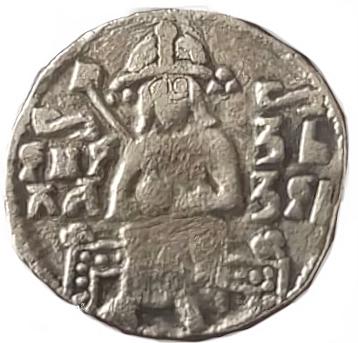
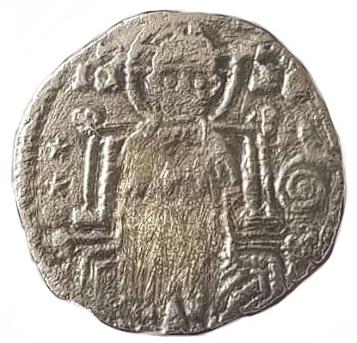
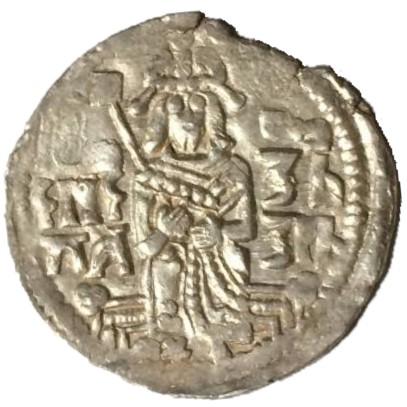
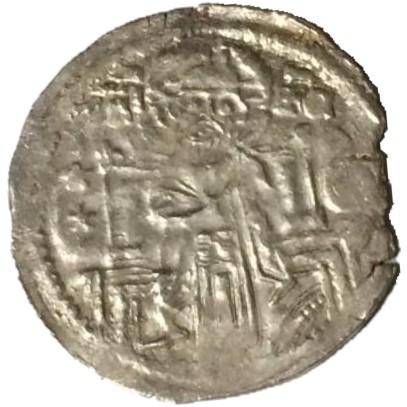
Map of the Serbian state under Prince Lazar Hrebeljanovic (1371-1389), covering an area from the Mačva and Moravice on the west to the river South Morava on the east and from the mountain Rudnik on the north to the Vuk Brankovic and Konstantin Dragaš land on the south.
МИ ГОСПОДИН ЗЕМЉЕ СРПСКЕ И ПОМОРЈА И СТРАНАМА ПОДУНАВСКИМ У ХРИСТА БОГА БЛАГОВЕРНИ И САМОДРЖИВИ ПО МИЛОСТИ БОЖЈОЈ СТЕФАН КНЕЗ ЛАЗАР
I, LORD OF THE SERBIAN LAND AND SEA COAST AND THE DANUBE SIDES IN CHRIST GOD THE PIOUS AND AUTOCRATIC BY THE GRACE OF GOD STEFAN KNEZ LAZAR
Prince Stefan Lazar Hrebeljanovic (1371-1389).
Silver "horns" type. 17mm, 0.763g.
Obverse: Ox-horned helmet (heraldic symbol of the Hrebeljanovic-Lazarevic dynasty) facing to the left. Uncertain Latin legend. Two triple dotted pellets as a maker marks one on each side. Possible S on the bottom right corner of the helmet.
Reverse: Christ bust facing, holding book of gospels decorated with 5 gems. Latin initials: IC - XC (In Greek: Ιησούς Χριστός - Jesus Christ) above. R and V siglas to the sides.
Reference: J 32-21, Jov 32 23, I 24.24.
Comment: Extremely rare and scarce example of Prince Lazar coinage. This is type that was found in a small hoard of 27 coins together with few coins of emperor Stefan Uros . That information as well as moneyer marks R and V that were used on Uros and his father Dusan coins confirm that this example has been issued for Lazar but under and with the approval of Uros.
Lazar name and title is also missing in fact description is unclear, letters appear random ISEIR IPRVS.
Date of minting is probably near the end of emperor Uros rule who died December 1371 or possibly just after his death 1372.
In 1365, the most powerful Serbian nobleman Vukašin Mrnjavčević became co-ruler with Emperor Uros and was granted the title of Serbian King. Serbia had emperor and a king at the same time. 6 years later, couple month or around 10 weeks before Uros died, Vukasin dies 27th September 1371 at the battle of Maritsa.
Lazar name and title is also missing on this coin, in fact description is unclear, letters appear random ISEIR IPRVS. He probably didn’t want to provoke or insult emperor Uros or the newly appointed co-ruler king Vukasin.
Even though Vukasin son Marko Mrnjavcevic know as Marko Kraljevic (son of the king) inherited royal crown, real power in Serbia, after passing of king Vukasin and emperor Uros, was held by Lazar. Although he has been called Czar Lazar he never took that title or the title of the king but the title of Duke or Prince.
Only 40 registered examples.
Reference: #LAZ21
Not For Sale
Estimated Value: 500 - 600 -700
Prince Lazar Coat of Arms
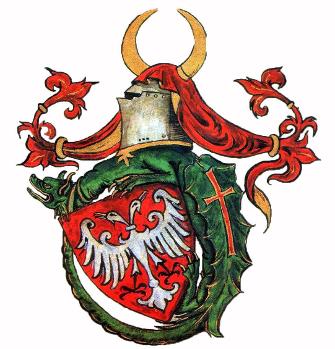
Prince Stefan Lazar Hrebeljanovic (1371-1389)
Silver "5 lines" coin. 18mm, 1.099g.
Obverse: Serbian Cyrillic legend in 5 rows: ВbХА БАБΛГО ВЪPNНH KNE3БΛ Α3ΑP (U Hrista boga blagoverni Knez Lazar (In Christ god pious Prince Lazar)). Triple dotted pellet as a maker mark at the end of 1st line and a single dot at the beginning of 5th line.
Reverse: Christ facing standing in front of the throne, holding Book of Gospels decorated with 5 gems. Latin initials: IC - XC (In Greek: Ιησούς Χριστός - Jesus Christ) above. 4 stars around on both sides. Flower like circles on both sides of the throne.
Reference: LJ XI-22, J 32-1, J 147, I 24.2, D 178 15.
Comment: Extremely rare and scarce example of Prince Lazar coinage. This is type that the Museum of Krusevac identified as being made by the same moneyer same money maker that Nobleman Djuradj I Balsic Lord of Zeta (1362-1378) used in making his own first coins, please check Numizmaticar Belgrade 2005 No 24/25 pages 229-232 and Numizmaticki Casopis Dinar no25 2005 page 24 below.
Only 20 registered examples.
Reference: #LAZ10
Not For Sale
Estimated Value: 300 - 400 - 500
Detail from Fresco of Lazar Hrebeljanović in Ljubostinja monastery, near Trstenik, Serbia. XV century (1402-1405).
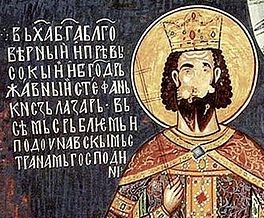

|
The New Type of Coin of Đurđe Balšić.pdf Size : 145.342 Kb Type : pdf |

|
Numizmaticki Casopis Dinar no25 2005 p24.pdf Size : 427.11 Kb Type : pdf |
Prince Stefan Lazar Hrebeljanovic (1371-1389)
Silver "5 lines" coin. 18mm, 0.664g.
Obverse: Serbian Cyrillic legend in 5 rows: ВbХА БАБΛГ ВЪONНH KNE3Б Α3Α (U Hrista boga blagoverni Knez Lazar (In Christ god pious Prince Lazar)). 2 dots and a line as a maker marks at the end of the first line.
Reverse: Christ facing standing in front of the throne, holding book of gospels decorated with 5 gems. Latin initials: IC - XC (In Greek: Ιησούς Χριστός - Jesus Christ) above. Siglas S - S above each other on the left side on the throne back.
Reference: J 32-2, J 148, D 177 10-13.
Comment: Extremely rare and scarce example of Prince Lazar coinage.
In the wake of emperor Uros death and following the defeat by the Ottomans in 1371, Lazar emerged as a powerful force from the ranks of nobility. His early coinage here with the "5-line" similar description is repeating the style and imagery of imperial issues of emperor Stefan Dusan as well as king Vukasin even though he is not taking title of a emperor or king but modestly a title of a prince.
Only 15 registered examples.
Reference: #LAZ16
Not For Sale
Estimated Value: 300 - 400 - 500
Prince Lazar Coat of Arms.
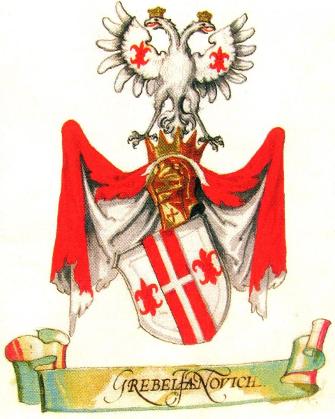
Prince Stefan Lazar Hrebeljanovic (1371-1389)
Silver "5 lines" coin. 18mm, 0.885g.
Obverse: Serbian Cyrillic legend in 5 rows: ВbХА+ БАБΛГО ВЪPNНH KNE3БΛ Α3ΑP (U Hrista boga blagoverni Knez Lazar (In Christ god pious Prince Lazar)). Triple dotted pellet as a maker mark at the end of 1st line.
Reverse: Christ facing standing in front of the throne, holding book of gospels, Latin initials: IC - XC (In Greek: Ιησούς Χριστός - Jesus Christ) above. Siglas V - V on the bottom on each side with stars around. Circles on the throne.
Reference: LJ XI-22, J 32-1,J 147, I 24.2, D 178 14.
Comment: Extremely rare and scarce example of Prince Lazar coinage. The only difference from above is that V - V initials are located lower nearer the throne. Slight damage but lovely toning and patina.
Only 20 registered examples.
Reference: #LAZ11
Not For Sale
Estimated Value: 300 - 400 - 500
Button from Prince Lazar attire.
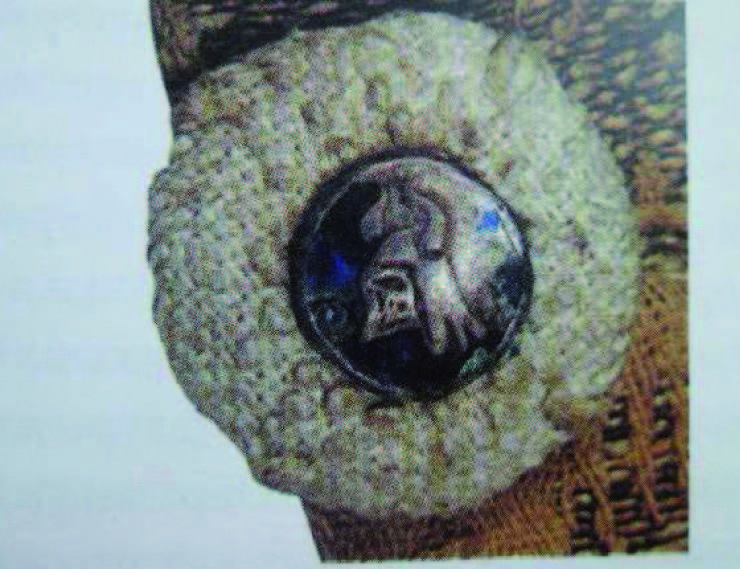
Prince Stefan Lazar Hrebeljanovic (1371-1389)
Silver "scepter" coin. 17mm, 0.889g.
Obverse: Lazar enthroned in imperial attire wearing a crown and holding a small scepter. Cyrillic legend: KNE 3b ΛA 3Pb ("PRINCE LAZAR") around.
Reverse: Christ enthroned, holding book of gospels decorated with gems. Greek legend: IC - XC (In Greek: Ιησούς Χριστός - Jesus Christ) above. 2 stars on the left side and sigla δ (Greek delta) on the right side.
Reference: J 144, Jov 32 3, LJ (XI-11), I (24.3).
Comment: It is uncertain when Lazar had taken the title of knez, which is usually translated as "prince". The earliest source that testifies to Lazar's new title is a Ragusan document in Latin, dated 22 April 1371, in which he is referred to as Comes Lazarus. Ragusans used comes as a Latin translation of the Serbian title knez. The same document relates that Lazar held Rudnik at that time.
45 registered examples.
Reference: #LAZ22
Not For Sale
Estimated Value: 200 - 300 - 400
Fresco of Prince Lazar from Curtea de Arges monastery.
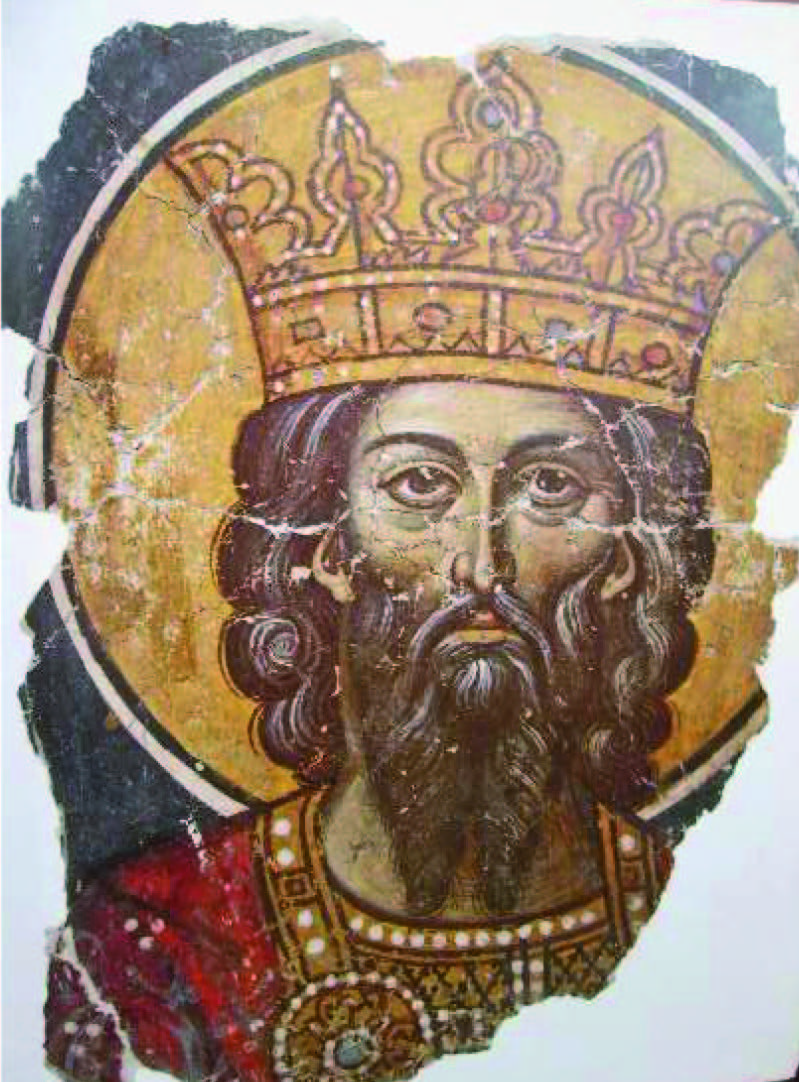
Prince Stefan Lazar Hrebeljanovic (1371-1389)
Silver "scepter" coin. 18mm, 1.211g.
Obverse: Lazar enthroned in imperial attire wearing a crown and holding a small scepter. Cyrillic legend: IPN P3b ΛA 3Pb ("PRINCE LAZAR") around.
Reverse: Christ enthroned, holding book of gospels decorated with gems. Greek legend: IC - XC (In Greek: Ιησούς Χριστός - Jesus Christ) above. Sigla δ (Greek delta) on the right side.
Reference: Unpublished variant compare to Jov 32 3, LJ (XI-11), I (24.3).
Comment: In medieval Serbia, knez was not a precisely defined term, and the title had no fixed rank in the feudal hierarchy. Its rank was high in the 12th century, but somewhat lower in the 13th century and the first half of the 14th century. During the reign of emperor Uros, when the central authority declined, the high prestige of the title of knez was restored.
Prince Stefan Lazar Hrebeljanovic (1371-1389)
Silver "scepter" coin.
Obverse: Lazar enthroned in imperial attire wearing a crown and holding a small scepter. Cyrillic legend: KNE 3b ΛA 3Pb ("PRINCE LAZAR") around.
Reverse: Christ enthroned, holding book of gospels decorated with gems. Greek legend: IC - XC (In Greek: Ιησούς Χριστός - Jesus Christ) above. V with the line underneath on the left side and sigla δ (Greek delta) on the right side.
Reference: J 144, Jov 32 3, LJ (XI-11), I (24.3).
Comment: This rare example is different from the one above in the way how Jesus face looks and a different moneyer mark on the left side, V instead of 2 stars.
This example has very similar image of the ruler to Uros example so its possible that it has been minted by the same moneyer. Please see picture below.
45 registered examples.
Prince Stefan Lazar Hrebeljanovic (1371-1389)
Silver "scepter" coin. 16mm, 0.712g.
Obverse: Lazar enthroned in imperial attire wearing a crown and holding a small scepter. Cyrillic legend: KNE 3b ΛA 3Pb ("PRINCE LAZAR") around.
Reverse: Christ enthroned, holding book of gospels decorated with gems. Greek legend: IC - XC (In Greek: Ιησούς Χριστός - Jesus Christ) above. 2 stars on the left side and sigla δ (Greek delta) on the right side.
Reference: J 144, Jov 32-3, LJ (XI-11), I (24.3).
Comment: Similar to example above but due to difference in letters minted by different moneyer.
45 registered examples.
Reference: #LAZ25 (SOLD)


Prince Stefan Lazar Hrebeljanovic (1371-1389)
Silver "scepter" coin. 17mm, 0.900g.
Obverse: Lazar facing in loros, crown and with scepter, standing before throne (or on dais), Serbian legend KH3 ΛA3P (PRINCE LAZAR) around.
Reverse: Christ enthroned, holding book of gospels decorated with 5 gems.
Reference: Jov 32-5, J 32-7.3,LJ (XI-14), I (24.5).
Comment: A very scarce type in excellent detail issued during Lazars reign. Lazar was born in 1329, Duke (KNEZ) of all lands of the Serbs 1371-1389. Ruled for 18 years. He died at the famous Battle of Kosovo in 1389 at 60 years of age. Lazar fielded his army taking the center field and flanked by troops from his allies Vuk Brankovic and King Tvrtko. Although analyses of contemporary sources indicate the outcome was more of a draw - both leaders were dead, and their armies withdrew amid heavy casualties. Tvrtko celebrated it as a victory for Christians. Today his remains are kept in the Ravanica Monastery.
Only 10 registered examples.
Reference: #LAZ1
Not For Sale
Estimated Value: 150 - 200 -250
Prince Stefan Lazar Hrebeljanovic (1371-1389)
Silver "scepter" coin. 17mm, 0.80g.
Obverse: Lazar facing in loros, crown and with scepter, standing before throne (or on dais), Serbian legend KH3 ΛA3P (PRINCE LAZAR) around.
Reverse: Christ enthroned, holding book of gospels decorated with 5 gems.
Reference: Jov 32-5, J 32-7.3,LJ (XI-14), I (24.5).
Comment: A very scarce type in excellent detail issued during Lazars reign. Legend looks slightly different from above example reference: #LAZ1.
Only 10 registered examples.
Reference: #LAZ15 (SOLD)
Prince Stefan Lazar Hrebeljanovic (1371-1389)
Silver "scepter" coin. 17mm, 1g.
Obverse: Crowned Lazar enthroned in imperial regalia. Serbian Cyrillic legend: KNE3b ΛA3Pb (PRINCE LAZAR)
Reverse: Christ enthroned, holding book of gospels decorated with 4 gems. Latin initials IC XC (In Greek: Ιησούς Χριστός - Jesus Christ) above, sigla G on the right side.
Reference: J 145, Jov 32-6.1, LJ (XI-13), I (24.4).
Comment: As its Serbian legend around this is certainly coin minted during Lazar reign as all the coins minted while he was alive had Serbian Cyrillic legend.
Only 14 registered examples.
Reference: #LAZ02
Not For Sale
Estimated Value: 150 - 200 - 250
Prince Stefan Lazar Hrebeljanovic (1371-1389)
Silver "scepter" coin. 17mm, 0.9g.
Obverse: Lazar facing, in loros and with scepter. Serbian legend: KNE3bI ΛA3PbI (PRINCE LAZAR) around.
Reverse: Christ on low-back throne, holding book of gospels, right hand outstretched, initials IC XC (In Greek: Ιησούς Χριστός - Jesus Christ) above, sigla.
Reference: Jov 32-7, LJ (XI-15), I (24.6).
Comment: In charters issued between 1379 and 1388, he named himself as Stefan Lazar. "Stefan" was the name borne by all Nemanjić rulers, leading the name to be regarded as a title of Serbian rulers. Tvrtko added "Stefan" to his name when he was crowned king of the Serbs and Bosnia. In the charters, Lazar referred to himself as the autocrator (samodržac in Serbian) of "All Serbian Lands", or the autocrator of "All the Serbs". Autocrator, "self-ruler" in Greek, was an epithet of the Byzantine emperors. The Nemanjić kings adopted it and applied it to themselves in its literal meaning to stress their independence from Byzantium, whose supreme suzerainty they nominally recognized.
Reference: #LAZ04
Not For Sale
Estimated Value: 100 - 150 - 200
Prince Stefan Lazar Hrebeljanovic (1371-1389)
Silver "scepter" coin of Novo Brdo. 17mm, 0.812g.
Obverse: Prince standing, facing, bear-headed, holding scepter. Legend: KNE3b ΛA3ARb (PRINCE LAZAR) around. 2 triple dotted marks, one on each side.
Reverse: Christ in glory, seating on the throne, holding book of gospels decorated with 5 gems , sigla P on the left side. IC ↄI above.
Reference: Unpublished.
Comment: Toned, uneven strike with lovely patina. Unique, unpublished example in Serbian numismatics, crude strike and a mystery as to design and origin but most likely made in Prince Lazar name after his death at Kosovo battle in 1389.
Reference: #LAZ20
Not For Sale
Estimated Value: 100 - 150 - 200
Prince Stefan Lazar Hrebeljanovic (1371-1389)
Silver "scepter" coin. 1.3g.
Obverse: Lazar enthroned in imperial regalia. Cyrillic legend: KNE 3b ΛA 3Pb (PRINCE LAZAR) around.
Reverse: Christ enthroned, holding book of gospels, initials IC XC (In Greek: Ιησούς Χριστός - Jesus Christ) above, sigla * - G.
Reference: J 144, Jov 32-3, LJ (XI-11), I (24.3).
Comment: Nice example with full title and name.
Order info: #LAZ03. (SOLD)


Prince or Duke Stefan Lazar Hrebeljanovic (1371-1389)
Silver "scepter" coin. 17mm, 0.665g.
Obverse: Ruler enthroned facing, holding cross tipped scepter, not wearing crown. Serbian legend H3 ΛΗ could well be KH3 ΛΗ (KNEZ LAZAR or DUKE LAZAR).
Reverse: Christ standing facing R - V to the sides. Greek letters: IC XC (In Greek: Ιησούς Χριστός - Jesus Christ) above.
Reference: J 158, Jov 12-29, I (24-22), D (129).
Comment: Because of R - V moneyer marks on the reverse, common during the rule of emperor Stefan Dusan and emperor Uros, certainly issued during emperor Uros reign around 1371but because of description on the obverse attributed to Knez Lazar.
Reference: #URV12
Not For Sale
Estimated Value: 100 - 150 - 200
Prince or Duke Stefan Lazar Hrebeljanovic (1371-1389)
Silver "scepter" coin. 17mm, 0.553g.
Obverse: Ruler enthroned facing, holding cross tipped scepter, not wearing crown. Serbian legend II3 ΛΗ could well be KH3 ΛΗ (KNEZ LAZAR or DUKE LAZAR). Halo around his head.
Reverse: Christ standing facing R -V to the sides. Greek letters: IC XC (In Greek: Ιησούς Χριστός - Jesus Christ) above.
Reference: J 158, Jov 12-29, I (24-22), D (129).
Comment: Because of R - V moneyer marks on the reverse, common during the rule of emperor Stefan Dusan and emperor Uros, certainly issued during emperor Uros reign around 1371 but because of description on the obverse attributed to Knez Lazar.
Reference: #URV13
Not For Sale
Estimated Value: 100 - 150 - 200
Prince or Duke Stefan Lazar Hrebeljanovic (1371-1389)
Silver "scepter" coin. 17mm, 0.487g.
Obverse: Ruler enthroned facing, holding cross tipped scepter, not wearing crown. Serbian legend H3 ΛΗ could well be KH3 ΛΗ (KNEZ LAZAR or DUKE LAZAR).
Reverse: Christ standing facing R -V to the sides. Greek letters: IC XC (In Greek: Ιησούς Χριστός - Jesus Christ) above.
Reference: J 158, Jov 12-29, I (24-22), D (129).
Comment: Because of R - V moneyer marks on the reverse, common during the rule of emperor Stefan Dusan and emperor Uros, certainly issued during emperor Uros reign around 1371 but because of description on the obverse attributed to Knez Lazar.
Reference: #URV17
Not For Sale
Estimated Value: 100 - 150 - 200
Prince or Duke Stefan Lazar Hrebeljanovic (1371-1389)
Silver "scepter" coin. 17mm, 0.779g.
Obverse: Ruler enthroned facing, holding cross tipped scepter, not wearing crown. Serbian legend I3I ΛΗ could well be KH3 ΛΗ (KNEZ LAZAR or DUKE LAZAR).
Reverse: Christ standing facing R -V to the sides. Greek letters: IC XC (In Greek: Ιησούς Χριστός - Jesus Christ) above.
Reference: J 158, Jov 12-29, I (24-22), D (129).
Comment: Because of R - V moneyer marks on the reverse, common during the rule of emperor Stefan Dusan and emperor Uros, certainly issued during emperor Uros reign around 1371 but because of description on the obverse attributed to Knez Lazar.
Reference: #URV19
Not For Sale
Estimated Value: 100 - 150 - 200
Prince or Duke Stefan Lazar Hrebeljanovic (1371-1389)
Silver "scepter" coin. 17mm, 0.862g.
Obverse: Ruler enthroned facing, holding cross tipped scepter, not wearing crown. Serbian legend H3 ΛΗ could well be KH3 ΛΗ (KNEZ LAZAR or DUKE LAZAR).
Reverse: Christ standing facing R -V to the sides. Greek letters: IC XC (In Greek: Ιησούς Χριστός - Jesus Christ) above.
Reference: J 158, Jov 12-29, I (24-22), D (129).
Comment: Because of R - V moneyer marks on the reverse, common during the rule of emperor Stefan Dusan and emperor Uros, certainly issued during emperor Uros reign around 1371 but because of description on the obverse attributed to Knez Lazar.
Reference: #URV21
Not For Sale
Estimated Value: 100 - 150 - 200
Prince or Duke Stefan Lazar Hrebeljanovic (1371-1389)
Silver "scepter" coin. 17mm, 0.392g.
Obverse: Ruler enthroned facing, holding cross tipped scepter, not wearing crown. Serbian legend H3 ΛΗ could well be KH3 ΛΗ (KNEZ LAZAR or DUKE LAZAR).
Reverse: Christ standing, facing, holding Book of Gospels decorated with 4 gems, R -V to the sides. Greek letters: IC XC (In Greek: Ιησούς Χριστός - Jesus Christ) above.
Reference: J 158, Jov 12-29, I (24-22), D (129).
Comment: Because of R - V moneyer marks on the reverse, common during the rule of emperor Stefan Dusan and emperor Uros, certainly issued during emperor Uros reign around 1371 but because of description on the obverse attributed to Knez Lazar.
Reference: #URV22
Not For Sale
Estimated Value: 100 - 150 - 200
Prince or Duke Stefan Lazar Hrebeljanovic (1371-1389)
Silver "scepter" coin. 17mm, 0.761g.
Obverse: Ruler enthroned facing, holding cross tipped scepter, not wearing crown. Serbian legend: H3 ΛΗ (KNEZ LAZAR or DUKE LAZAR).
Reverse: Christ standing facing R -V to the sides. Greek letters: IC XC (In Greek: Ιησούς Χριστός - Jesus Christ) above.
Reference: J 158, Jov 12-29, I (24-22), D (129).
Comment: Because of R - V moneyer marks on the reverse, common during the rule of emperor Stefan Dusan and emperor Uros, certainly issued during emperor Uros reign around 1371 but because of description on the obverse attributed to Knez Lazar.
Reference: #URV45
Not For Sale
Estimated Value: 100 - 150 - 200
Prince or Duke Stefan Lazar Hrebeljanovic (1371-1389)
Silver "scepter" type. 17mm, 0.747g, Jovanovic owned.
Obverse: Ruler enthroned facing, holding cross tipped scepter, not wearing crown. Serbian legend H3 ΛΗ could well be KH3 ΛΗ (KNEZ LAZAR or DUKE LAZAR).
Reverse: Christ seating on the throne, holding Book of Gospels, facing, R -V to the sides. Greek letters: IC XC (In Greek: Ιησούς Χριστός - Jesus Christ) above.
Reference: J 158, Jov 12-29, I (24-22), D (129).
Comment: Because of similarity with the coins of Duke Lazar many numismatists attribute this coin to Lazar. What makes this coin special is the fact that belonged to Jovanovic himself and picture of it is in his book Serbien Medieval Coins Belgrade 2002 issue page 55 number 29 and in also published in Numizmaticki Casopis Dinar no10 issued in 1998 page 12 picture no3. Please see below. It was sold by his widow after his death.
Reference: #URV11
Not For Sale
Estimated Value: 100 - 150 - 200
Prince or Duke Stefan Lazar Hrebeljanovic (1371-1389)
Silver "cross" coin minted after 1389. 13mm, 0.4g.
Obverse: Prince standing facing, holding banner with saint in profile, unclear legend around.
Reverse: Christ in glory, blessing, unclear legend around.
Reference: Jov 32-H3, J 32-26,I (25.2).
Comment: As the Ottoman threat increased and the support for Sigismund grew in Hungary, Lazar made peace with Sigismund, who was crowned Hungarian king in March 1387. The peace was sealed, probably in 1387, with the marriage of Lazar's daughter Teodora to Nicholas II Garay, a powerful Hungarian noble who supported Sigismund. Around the same year, Lazar's daughter Jelena married Djuradj Stracimirović Balšić. About a year before, Lazar's daughter Dragana married Alexander, the son of Ivan Shishman, Tsar of Bulgaria.
Irregular coinage, contemporary forgery of the coins of Venice.
Reference: #LAZ09
Not For Sale
Estimated Value: 100 - 150 - 200
Copyright © 2020